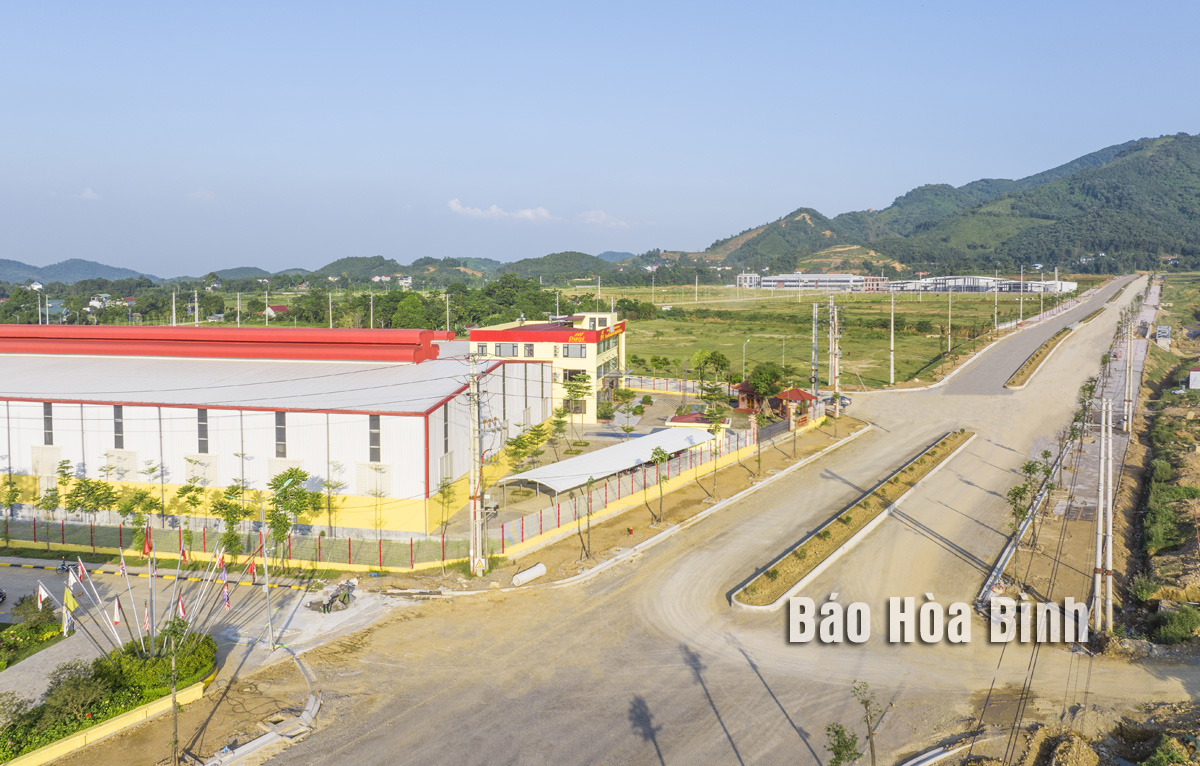
A revolution is unfolding in Hoa Binh province, with broad roads stretching across the terrain, industrial zones humming with machinery, organic vegetable fields rolling out in vibrant green expanses, and tourism destinations emerging, rich with cultural identity.
The determination and unity of the Party committees and
administrations at all levels and the local people have created foundational
changes in the province’s economic restructuring and renewal of the economic
growth model.
Hoa Binh
province has paid due attention to developing industrial parks and clusters. In
the Photo: The Tien Tien Industrial Cluster in Quang Tien commune, Hoa Binh
city.
The journey began in 2016 when Hoa Binh worked
to restructure its economic model. Four years later, the results were
promising, with economic scale rising by 41%, to reach nearly 52 trillion VND
(over 2 billion USD) in 2020, and per capita regional domestic product (GRDP)
touching 60.3 million VND.
Resolution
No.09-NQ/TU sets bold roadmap for economic development
The Standing Board of the provincial Party’s
Committee issued Resolution No.09-NQ/TU on December 31, 2021, a comprehensive
blueprint for local economic restructuring. The ambitious plan aims to bring
Hoa Binh's economic performance up to the national average by 2025, with specific,
transformative targets.
Key objectives include achieving an average
annual GRDP growth of 9%, increasing labor productivity by 8% annually, and
reducing poverty rates by 2.5-3% each year for 2021-2025.
The province set its sights on attracting 280
domestic projects worth over 120 trillion VND and 30 foreign direct investment
(FDI) projects valued at some 1 billion VND.
Under the resolution, various large-scale
projects and plans have been brought into full play, with the one on
restructuring the local economy in tandem with the renewal of economic growth
motive aimed at improving the efficacy of investment allocation and use,
developing industries and projects on the basis on the local strengths and
those with high added value and competitive edge, and enhancing labour
productivity, among others.
Capitalising on the Government’s support, the
province has issued various special policies to attract investments and
mobilise resources. Besides, the national target programmes on building
new-style rural areas and sustainable poverty alleviation have been integrated
with the economic restructuring efforts.
The provincial planning for 2021-2030 with a
vision to 2050 was greenlighted by the Prime Minister in late 2023. It looks to
inclusive and harmonious development with four pillars of processing and
manufacturing industry, clean and organic agriculture, tourism, and development
of satellite urban areas in tandem with the preservation of local ethnic
groups’ culture. This is the guiding principle for the province to restructure
its economic sectors in an effective and sustainable fashion.
A quiet yet powerful transformation unfolds as
those used to hillside farms and kitchen duties now set aside their routines to
learn to change. The entire rural landscape seems to awaken from years of
clinging solely to farmlands. Now locals are gearing towards the future with
new hopes. However, even with determination and strong consensus, the
province’s economic restructuring journey is not without challenges. What are
they and what has Hoa Binh done to overcome the obstacles?
To be continued
Dao Village’s honey – a product certified with a 3-star OCOP (One Commune One Product) rating by Thong Nhat Agricultural Cooperative in Dao Village (Hoa Binh City) – is highly regarded by consumers for its quality, richness, and variety in packaging. The distinctively sweet taste of Dao Village’s honey leaves a lasting impression on anyone who has tried it.
In alignment with Project No. 07-DA/TU, issued by the Hoa Binh provincial Party Committee on November 1, 2021, Lac Thuy district has actively promoted investment and supported the sustainable development of its industrial and handicraft sectors during the 2021–2025 period. Alongside this, the district has remained committed to preserving and revitalising traditional craft villages.
Located in the northern part of Lac Thuy district, with a temperate climate and fertile soil, Phu Thanh commune has great potential and advantages in growing tea. The long-standing experience, combined with strict adherence to organic farming practices in the tea gardens, ensures that the dried tea products from Phu Thanh and Lac Thuy as a whole are sold out immediately upon production, providing a stable and prosperous life for the local people.
Amid efforts to streamline the administrative apparatus, Hoa Binh province has intensified measures to address challenges in land clearance, resettlement support, and infrastructure investment, aiming to speed up the progress of key projects.
Hoa Binh province has posted an unprecedented economic growth rate of 12.76% in the first quarter of 2025, marking its highest quarterly performance to date and positioning it as the second fastest-growing locality in the country, trailing only Bac Giang province.
Under current regulations, products in the One Commune – One Product (OCOP) programme that are rated three stars or higher must undergo re-evaluation every three months. However, in reality, some of these products fail to consistently meet the required standards, raising concerns about the sustainability of their OCOP certification. This underscores the urgent need for producers to enhance product quality and gradually develop their OCOP products into strong, marketable brands.



